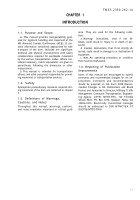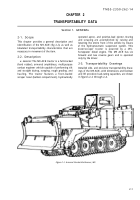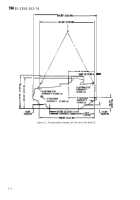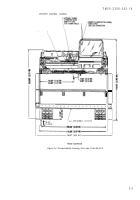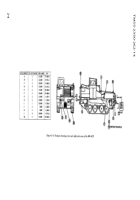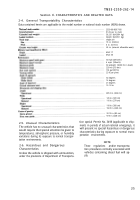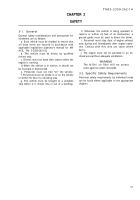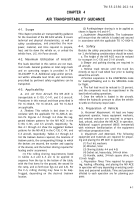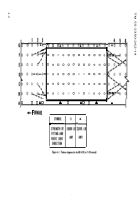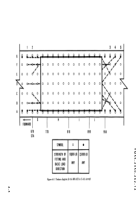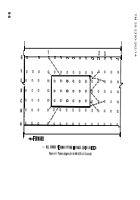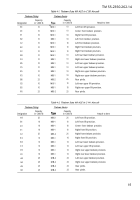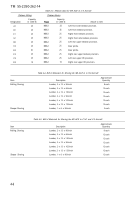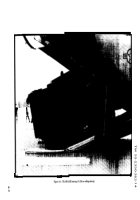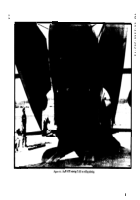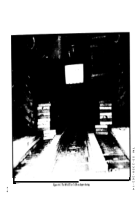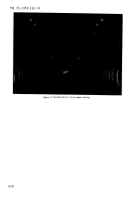TM-55-2350-262-14 - Page 14 of 42
CHAPTER
4
AIR TRANSPORTABILITY
TM
GUIDANCE
55-2350-262-14
4-1. Scope
This chapter provides air transportability guidance
for the movement of the M9 ACE vehicle. It covers
technical and physical characteristics, as well as
safety considerations,
and prescribes the man-
power, material, and time required to prepare,
load, and tie down the vehicle on, or unload the
vehicle from, U.S. Air Force aircraft.
4-2. Maximum Utilization of Aircraft
The loads described in this section are not maxi-
mum loads. General guidance on total cargo loads
and on operating ranges is provided in TM
38–236/AFP 71–8. Additional cargo and/or person-
nel within allowable load limits and restrictions
prescribed by pertinent safety regulations can be
transported.
4-3. Applicability
a.
U.S. Air Force Aircraft.
The M9 ACE is
transportable in C–130, C–141, and C–5 aircraft.
Procedures in this manual and those prescribed in
TO 1C-130A-9, TO 1C-141A-9, and TO 1C-5A-9
are applicable.
b. Tiedown.
This vehicle is tied down in ac-
cordance with the applicable TO 1C–XXX–9, sec-
tion IV. Figures 4–1 through 4–3 show the sug-
gested tiedown patterns for the M9 ACE in the
C-130, C-141, and C-5 aircraft, respectively. Ta-
bles 4-1 through 4-3 show the suggested tiedown
patterns for the M9 ACE in the C-130, C-141, and
C-5 aircraft, respectively. Tables 4-1 through 4-3
list the tiedown devices required, the locations of
tiedown points, the corresponding fittings to which
the devices are secured, the number and capacity
of the devices, and the lumber shoring required for
loading and/or securement.
(1) The rolling shoring requirements listed
in tables 4–4 and 4–5 are to be applied in
sequence from the top to the bottom of the table,
with the first items for the ground, the second for
the ramp, and so forth (see figs 4-4 and 4-5). For
the C–5, rolling shoring may have to be leap-
frogged, depending on the desired tiedown
location.
(2) Parking/sleeper shoring is to be applied as
shown in figures 4–6 and 4–7.
c.
Loadmaster Responsibilities.
The loadmaster
will ensure that the vehicle is loaded and secured
in accordance with the applicable TO 1C–XXX–9.
4-4. Safety
Besides the safety precautions contained in chap-
ter 3, the following considerations should be noted:
a. The height of the M9 ACE must be reduced
for transport in C-130 and C-141 aircraft.
b.
Sleeper and parking shoring are required in
all aircraft.
c. Relieve track tension until the track lies
directly on top of road wheel four prior to loading
aboard the aircraft.
d.
Position suspension to the UNSPRUNG mode
for loading/offloading and to the SPRUNG mode
for flight.
e. The fuel load must be reduced to 25 percent,
and the components must be repositioned in the
bowl before loading operations.
f. Once the vehicle is loaded in the aircraft,
relieve the hydraulic pressure to allow the vehicle
to settle on the bump stops faster.
4-5. Preparation of Vehicle
a.
Personnel Requirement.
At least one heavy
equipment operator, heavy equipment mechanic,
and wrecker operator are required to prepare,
load, unload, and place the M9 ACE in operation.
Additional support personnel (MOS immaterial)
with minimum familiarization of the equipment
will reduce preparation time.
b. Equipment and Materials.
The following
equipment and materials are required for prepar-
ing and placing the M9 ACE in operation:
(1) T
OO
l
kit, mechanic
(2) Wrecker, 5-ton
(3) Shoring (tables 4-4 and 4-5)
(4) Socket set, heavy-duty, 3/4-inch drive
(5) Handle, socket, 3/4-inch square drive, 20-
l/2-inch length
c.
Preparation Times.
Time required for prepar-
ing, loading, offloading, and placing the M9 ACE
in operation will vary depending on existing condi-
tions and personnel available. Time and personnel
allotted to each operation are for planning pur-
poses.
4-1
Back to Top

